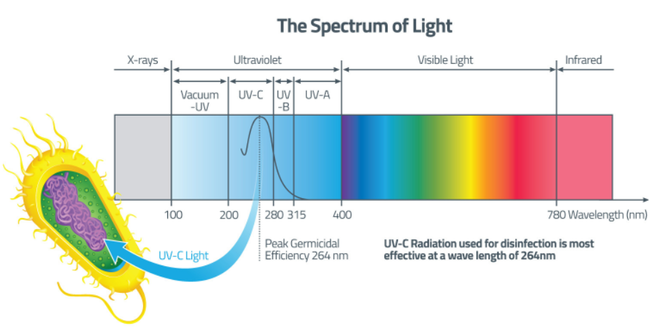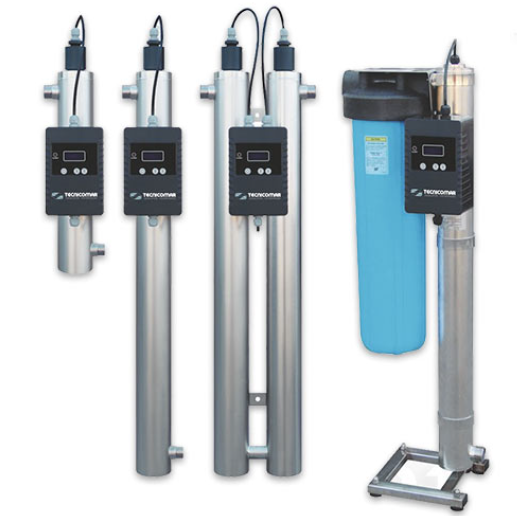UV light is a part of the natural electromagnetic spectrum. UV radiation is divided into four sub-categories based on the wavelength: UV-A (315 to 400 nm), UV-B (280 nm to 315 nm), UV-C (200 nm to 280 nm). and UV-Vacuum (under 200 nm).
The DNA of microorgamisms is most sensitive to UV-C radiation. (Living organisms haven’t evolved adequate defense mechanisms against ultraviolet rays, having always been protected by the ozonosphere.) The photochemical reaction resulting from exposure to UV-C light breaks the bonds within the DNA chain, thus preventing microorganisms from reproducing, and leading them to end their life cycle without giving rise to subsequent generations. The peak of maximum sensitivity of the DNA is at the wavelength 260nm; this explains the great effect of the low pressure UV-C lamps that generate emissions at 254nm.
UV irradiation deactivates the bacterial load in the water, without the use of chemicals, without altering the characteristics of the water and without generating any unpleasant or even harmful by-products. Of the possible types of UV lamps, mercury vapor has proven the best for water treatment. These lamps contain gas whose atoms, energized by an electric discharge, are excited and release the acquired energy in the form of electromagnetic radiation at specific wavelengths.
The wavelength generated is concentrated in peaks at 254nm and 185nm, in addition, a small amount of visible light is generated.
The quartz that covers the lamps can be "doped" to filter the radiation at 185nm depending on the applications, allowing the emission of only the visible portion (small) and that at 254nm effective for disinfection. The sizing of a UV treatment system therefore focuses on the radiation intensity produced within a finite reaction volume and on the contact time in which the microorganisms are exposed to the radiation.

The exposure time is reported as “microwatt-seconds per square centimeter” (uwatt-sec/cm2), and the U.S. Department of Health and Human Services has established a minimum exposure of 16,000 µwatt-sec/cm2 for UV disinfection systems. Most manufacturers provide a lamp intensity of 30,000-50,000µwatt-sec/cm2. In general, coliform bacteria https://extension.psu.edu/coliform-bacteria, for example, are destroyed at 7,000 µwatt-sec/cm2. Since lamp intensity decreases over time with use, periodic lamp replacement and proper pre-treatment are key to the success of a UV disinfection unit. The percentage of microorganisms destroyed depends on the intensity of the UV light, the contact time, water composition, and proper maintenance of the equipment. Most low-pressure mercury lamp UV disinfection systems can readily achieve UV radiation doses of 50-150 mJ/cm2 in high quality water, and therefore disinfect essentially all waterborne pathogens.
The relationship between the dose and the destruction achieved of a target micro-organism can be summarized as follows:
N/No = eKD
Where:
N = Initial Number of target organism
No = Number of target organisms after treatment
K = Constant associated with target organisms
D = Dose
The table below shows the dose in mJ/cm
Pathogen
1-Log (90%)
2-Log (99%)
3-Log (99.9%)
4-Log (99.99%)
Cryptosporidium parvum
1.3
2.5
4.3
5.7
Giardia lamblia cysts
.3
.7
1.3
1.7
Vibrio cholare
.8
1.4
2.2
2.9
Shigella dysenteriae
.5
1.2
2
3
Escherichia coli
1.5
2.8
4.1
5.6
Salmonella typhia
5
7
9
10
Hepatitis A virus
4.1 - 5.5
8.2 - 14
12.3 - 22
16.4 - 29.6
Polio type I
4.1 - 6
8.7 - 14
14.2 - 23
21.5 - 30
Coxsackie B5 virus
6.9
13.7
20.6
30
Rotavirus SA11
7.1 - 9.1
14.8 - 19
23 - 25
36
The manufacturers of ultraviolet ray sterilizers offer systems sized for flow rates ranging from a few liters to several hundreds cubic meters per hour. While for large plants the market offers well-engineered systems, buyers should be careful when buying small sterilizers, which are often sold by small companies with limited technological background.







